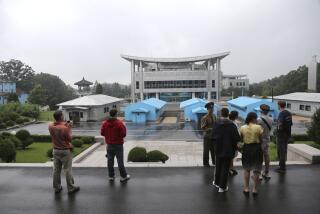Cold War Offers Sanctuary to Wildlife in DMZ
- Share via
CHURWON, South Korea — A pair of snow-white cranes swoop down to feed in a field just south of the Korean Demilitarized Zone, gracefully tucking in their long black-tipped wings.
“Defect! Come to the Worker’s Paradise!,” says a blast from loudspeakers on the Communist North Korean side of the zone. With a swoosh, the cranes take off, dizzyingly climbing the sky.
Here, at the Cold War’s last remaining frontier, one-third of the world’s remaining Manchurian cranes spend the winter in relative calm. The broadcasts of Communist propaganda are nothing compared to what could happen if peace comes to the divided Korean peninsula, environmentalists say.
So a small group of scientists and environmentalists is hoping to turn the 155-mile-long, 2.5-mile-wide demilitarized zone between Communist North and capitalist South into a permanent nature preserve.
Untouched by man since the end of the 1950-53 Korean War, the narrow strip running roughly along the 38th parallel sustains wildlife unequaled in other preserves in either Korea.
The majestic cranes feed in South Korea’s Churwon valley, but fly to the DMZ immediately north of the valley for safety at night.
Fragile edelweiss blooms undisturbed in the DMZ, guarded by 2 million soldiers along the world’s most heavily fortified border.
Half the world’s remaining black-faced spoonbills frolic there. And tiny sandpipers stop in the area to fatten up during the 375-mile flight from Siberia to Australia.
“The DMZ resulted from war. But from the seeds of the battles and the wounds, a beautiful preserve has been born,” said Yoon Moo-bu, professor of ornithology at Seoul’s Kyunghee University and a leading conservationist.
Keeping it that way will likely be an uphill battle.
K.C. Kim, a Korean American who heads Penn State’s Center for BioDiversity Research, is working to launch an international conference next year to bring together scientists from North and South Korea to talk about preservation of the area.
“To make it into a place of perpetual peace, all of Korean people must support it,” he said.
But getting the two Koreas together is thorny because they are still technically at war, never having signed a treaty to end the conflict.
Poverty is said to be preventing North Korea from turning its attention to nature preservation, while the culprit in South Korea is overdevelopment.
Ski slopes and golf courses have cropped up all over the South, and wild animals are difficult to spot, even inside national parks.
The prospect of better ties with North Korea after the fall of communism in Eastern Europe also prompted the military to return much of the once-strategic coastal land and nearby mountains to civilian control. That opened the pristine areas to frenzied development.
Such development is giving urgency to efforts to preserve the DMZ as nature’s last bulwark.
Already, many of the favorite feeding sites of the Manchurian cranes in the valley have been destroyed by development projects and tourist sites. Until last year only a handful of civilians were allowed to enter the area; now a lookout tower a stone’s throw from the DMZ invites a steady stream of tourist buses.
“The fools are building a highway next to the cranes,” fumed Yoon. “It makes my heart go crazy to see the destruction.”
The results of total peace--if there were to be a treaty or if financially beleaguered North Korea were to collapse--are unpredictable but frightening to ponder.
A collapse could mean tens of thousands of refugees flooding into the DMZ. A peace treaty would mean an end to the military buffer zone.
It’s also impossible to predict when either of those things might happen.
So, for now, the birds seem relatively safe. Safe, that is, as long as the two Koreas remain bitter enemies, and as long as recent other South Korean ideas for the DMZ--as a soccer field or nuclear waste site--are nixed.
More to Read
Sign up for Essential California
The most important California stories and recommendations in your inbox every morning.
You may occasionally receive promotional content from the Los Angeles Times.










